 |
 |
 |
 |
 |
 |
| |
 |
|
 |
 |
 |
  |
  |
 |
 |
 |
 |
|
 |
|
 |
 |
 |
NOTE BIOGRAFICHE |
 |
|  |
|
 |
 |
 |
| |
 |
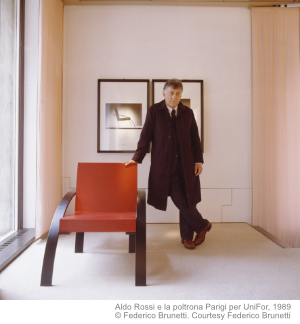 Aldo Rossi (1931-1997) compie la sua prima formazione negli anni Cinquanta presso il Politecnico di Milano. Assistente negli studi di Ignazio Gardella e Marco Zanuso, insegna con Ludovico Quaroni presso la Scuola urbanistica di Arezzo e con Carlo Aymonino allo IUAV di Venezia; professore incaricato al Politecnico di Milano nel 1959, vince la cattedra di caratteri degli edifici nel 1970, quando comincia a collaborare anche con diverse università americane tra cui la Cooper Union University, l’Institute for Architecture and Urban Studies, Harvard e Yale University. Aldo Rossi (1931-1997) compie la sua prima formazione negli anni Cinquanta presso il Politecnico di Milano. Assistente negli studi di Ignazio Gardella e Marco Zanuso, insegna con Ludovico Quaroni presso la Scuola urbanistica di Arezzo e con Carlo Aymonino allo IUAV di Venezia; professore incaricato al Politecnico di Milano nel 1959, vince la cattedra di caratteri degli edifici nel 1970, quando comincia a collaborare anche con diverse università americane tra cui la Cooper Union University, l’Institute for Architecture and Urban Studies, Harvard e Yale University.
L’attività progettuale si divide tra edilizia privata e pubblica. Si ricordano tra i primi progetti realizzati: l’ampliamento della scuola De Amicis di Broni (1970), un’unità residenziale al quartiere Gallaratese di Milano (1973), il Cimitero di San Cataldo di Modena (1978) e la scuola elementare di Fagnano Olona (1976). Successivamente: gli edifici pubblici di Fontivegge-Perugia e Borgoricco (1989), la ristrutturazione del Teatro Carlo Felice di Genova (1989), l’ampliamento dell’aeroporto di Milano-Linate (1993), fino al progetto per la ricostruzione del Teatro “La Fenice” di Venezia. Contemporaneamente la sua notorietà si afferma oltre i confini nazionali con realizzazioni quali l’isolato tra Kochstrasse e Friedrichstrasse a Berlino (1981), l’Hotel “Il Palazzo” di Fukuoka (1989) e a Maastricht il Bonnefantenmuseum (1994). L’attività di storico e teorico dell’architettura comprende, oltre alle collaborazioni con riviste quali “Casabella Continuità”, “Società” e “Il Contemporaneo”, la pubblicazione di Architettura della città (1966) e diA Scientific Autobiography (1981), oltre al film Ornamento e delitto e alla direzione della sezione internazionale di architettura alla Triennale di Milano (1973) e della sezione architettura della Biennale di Venezia del 1983. Architetto e studioso, nominato Accademico di San Luca nel 1979, insignito del Pritzker Prize 1990 e della 1991 Thomas Jefferson Medal in Architecture, Aldo Rossi è noto anche per la sua attività di designer – Alessi, Artemide, Longoni, Molteni, Unifor – e artista, dal Teatro del Mondo presentato alla Biennale di Venezia del 1979, al Monumento a Sandro Pertini (Milano, 1990), passando per l’opera pittorica e grafica, da sempre legata alla sua attività progettuale. |
|
 |
 |
 |
PREMI |
 |
|  |
|
 |
 |
 |
|
|
 |
|
|
|
 |
|
|
|
 |
| Pritzker Architecture Prize |
|
 |
 |
 |
OPERE |
 |
|
 |
|
 |
 |
 |
|
|
 |
|
|
  Italia
Italia
» Venezia |
|
|
|
|
 |
|
|
  Germania [Deutschland]
Germania [Deutschland]
» Berlino [Berlin] |
|
|
|
|
 |
|
|
|
 |
|
|
|
 |
|
|
  Italia
Italia
» Castellanza |
|
|
|
|
 |
|
|
  Italia
Italia
» Verbania |
|
|
|
|
 |
|
|
  Italia
Italia
» Pisa |
|
|
|
|
 |
|
|
  Italia
Italia
» Verbania |
|
|
|
|
 |
|
|
  Italia
Italia
» Milano |
|
|
|
|
 |
|
|
  Italia
Italia
» Milano |
|
|
|
|
 |
|
|
  Italia
Italia
» Genova |
|
|
|
|
 |
|
|
  Italia
Italia
» Milano |
|
|
|
|
 |
|
|
  Italia
Italia
» Rozzano |
|
|
|
|
 |
|
|
  Giappone [Nihon/Nippon]
Giappone [Nihon/Nippon]
» Fukuoka |
|
|
|
|
 |
|
|
  Italia
Italia
» Milano |
|
|
|
|
 |
|
|
|
 |
|
|
  Italia
Italia
» Parma |
|
|
|
|
 |
|
|
  Italia
Italia
» Torino |
|
|
|
|
 |
|
|
  Italia
Italia
» Borgoricco |
|
|
|
|
 |
|
|
  Italia
Italia
» Giussano |
|
|
|
|
 |
|
|
  Italia
Italia
» Broni |
|
|
|
|
 |
|
|
  Italia
Italia
» Goito |
|
|
|
|
 |
|
|
  Italia
Italia
» Pegognaga |
|
|
|
|
 |
|
|
  Italia
Italia
» Mozzo |
|
|
|
|
 |
|
|
  Italia
Italia
» Modena |
|
|
|
|
 |
|
|
  Italia
Italia
» Milano |
|
|
|
|
 |
|
|
  Italia
Italia
» Trieste |
|
|
|
|
 |
|
|
  Italia
Italia
» Fagnano Olona |
|
|
|
|
 |
|
|
  Italia
Italia
» Broni |
|
|
|
|
 |
|
|
  Italia
Italia
» Segrate |
|
|
 |
 |
 |
 |
BIBLIOGRAFIA |
 |
|
|
 |
|
 |
 |
 |
| SCRITTI DELL'AUTORE |
 |
|
|
 |
| Aldo Rossi, "Per la Triennale / On the Triennale", Abitare 479, febbraio/february 2008, pp. 55-61 (54-73) |
|
|
| Aldo Rossi, "Museo Bonnefanten / Bonnefanten Museum", Maastricht: il nuovo Céramique/Maastricht: the new Céramique, allegato a/published with Abitare 417, maggio/may 2002, pp. 48-50 |
|
|
| Aldo Rossi, "Un giovane architetto tedesco: Oswald Mathias Ungers / A Young German Architect: Oswald Mathias Ungers", Casabella 654, marzo/march 1998 [To be rather than to seem], pp. 18-19 (4-25) [republished from Casabella 244, ottobre/october 1960] |
|
|
| Aldo Rossi, "Isolato in Schützenstrasse a Berlino", Casabella 632, marzo/march 1996, pp. 26-39 (22-39) |
|
|
| Aldo Rossi, "La diversità di Berlino", Casabella 632, marzo/march 1996, pp. 22-25 (22-39) |
|
|
| Benedetto Gravagnuolo, Aldo Rossi, Adolf Loos. Theory and Works, Art data, 1995 |
|
|
| Aldo Rossi (text), Gabriele Basilico (photo), "Bonnefantenmuseum a Maastricht in Olanda / Bonnefantenmuseum at Maastricht in Holland", Domus 762, luglio-agosto/july- august 1994, "Progetti/Projects" pp. 8-17 (8-22) |
|
|
| Aldo Rossi, Disegni di Architettura 1967 - 1985, Mazzotta, 1986 |
|
|
"Dieci opinioni sul tipo / Ten Opinions on the Type", Casabella 509-510, gennaio-febbraio/january-february 1985 [I terreni della tipologia / The Grounds of Typology], pp. 92-111
Aldo Rossi, Casabella 509-510, gennaio-febbraio/january-february 1985 [I terreni della tipologia / The Grounds of Typology], pp. 100, 101 (92-111) |
|
|
| Aldo Rossi, Architetture padane, Edizioni Panini, 1984 |
|
|
Aldo Rossi, A scientific autobiography, The MIT Press, Cambridge (USA) 1981
tr.it.: Autobiografia scientifica, Pratiche Editrice, 1990 |
|
|
| Aldo Rossi, Progetti e Disegni. 1962-1979, Rizzoli, 1980 |
|
|
| Rosaldo Bonicalzi (ed.), Aldo Rossi. Scritti scelti sull'architettura e la città. 1956-1972, Clup, 1978 |
|
|
| Aldo Rossi, Scritti scelti sull'architettura e la città. 1956 - 1972, Clup, Milano 1975 |
|
|
| Aldo Rossi, L’architettura della città, Marsilio, Padova 1966 |
|
|
| Aldo Rossi, "Un giovane architetto tedesco: Oswald Mathias Ungers", Casabella 244, ottobre/october 1960, pp. 22-37 |
|
|
| Aldo Rossi, "Il Convento de La Tourette, di Le Corbusier", Casabella Continuità 246, 1960, pp. 4-19 |
|
|
| Aldo Rossi (ed.), Karl Kraus, Arnold Schönberg, Alban Berg, Anton Webern, Bruno Taut, Le Corbusier, Ezra Pound, Walter Gropius, Edoardo Persico, "Testimonianze su Adolf Loos", Casabella Continuità 233, novembre 1959 [Numero dedicato ad Adolf Loos], pp. 43-45 (43-46) |
|
|
| Aldo Rossi (ed.), "Elenco delle opere", Casabella Continuità 233, novembre 1959 [Numero dedicato ad Adolf Loos], pp. 21-28 |
|
|
| Aldo Rossi, "Adolf Loos, 1870-1933", Casabella Continuità 233, novembre 1959 [Numero dedicato ad Adolf Loos], pp. 5-12 |
|
|
|
 |
 |
 |
| SCRITTI SULL'AUTORE |
 |
|
|
 |
| Beatrice Lampariello, Aldo Rossi e le forme del razionalismo esaltato. Dai progetti scolastici alla «città analoga». 1950-1973, Quodlibet Habitat, 2017 |
|
|
Stefano Boeri, Abitare 479, febbraio/february 2008, p. 54 (54-73)
Paola Nicolin, "La mostra come Architettura Autonoma: un testo di Aldo Rossi / The exhibition as Autonomous Architecture: a text by Aldo Rossi", Abitare 479, febbraio/february 2008, p. 55 (54-73) |
|
|
 Germano Celant (ed.), Aldo Rossi. Disegni, Skira, Milano 2008 Germano Celant (ed.), Aldo Rossi. Disegni, Skira, Milano 2008 |
|
|
 Annalisa Trentin (ed.), La lezione di Aldo Rossi, Bononia University Press, 2008 Annalisa Trentin (ed.), La lezione di Aldo Rossi, Bononia University Press, 2008 |
|
|
| Attilio Pizzigoni, Architettura dell'architettura. Aldo Rossi e il primato della realtà, Sestante, Bergamo 2006 |
|
|
Rafael Moneo, Inquietud teórica y estrategia proyectual en la obra de ocho arquitectos contemporáneos, Actar, Barcelona 2004
tr.en.: Theoretical anxiety and design strategies in the work of eight contemporary architects, MIT Press, Cambridge (MA) 2004 |
|
|
| Pisana Posocco, Gemma Radicchio, Gundula Rakowitz (ed.), Scritti su Aldo Rossi. «Care architetture», Umberto Allemandi & C., Torino 2003 |
|
|
| Alberto Ferlenga (ed.), Aldo Rossi. Tutte le opere, Electa, Milano 2003 |
|
|
| Alberto Ferlenga (ed.), Aldo Rossi. The Life and Works of an Architect, Konemann, 2001 |
|
|
| Francesco Dal Co (ed.), Aldo Rossi. I quaderni azzurri, Electa, Milano 1999 |
|
|
| Marco Brandolisio, Ghego Da Pozzo, Max Scheurer, Michele Tadini (ed.), Aldo Rossi. Disegni. 1990-1997, Federico Motta Editore, Milano 1999 |
|
|
| Marco Brandolisio, Giovanni Da Pozzo, Massimo Scheurer, Michele Tadini, "Aldo Rossi in Italia Settentrionale / Aldo Rossi in northern Italy", Domus 805, giugno/june 1998 [Sensorialità/Sensoriality], "Itinerario/Itinerary 146" pp. 103-110 |
|
|
| Arduino Cantàfora "Poche e profonde cose / A few Deep Things", Casabella 654, marzo/march 1998 [To be rather than to seem], pp. 4-7 (4-25) |
|
|
| Salvatore Farinato (ed.), Per Aldo Rossi, Marsilio Editore, Venezia 1998 |
|
|
| Albeerto Ferlenga (ed.), Aldo Rossi. Opera completa. 1993-1996, Electa, Milano 1996 |
|
|
| Alexander van Grevenstein, "Lettera ad Aldo Rossi / Letter to Aldo Rossi", Domus 762, luglio-agosto/july- august 1994, "Progetti/Projects" pp. 18-22 (8-22) |
|
|
| Alberto Ferlenga (ed.), Aldo Rossi. Architetture. 1988-1992, Electa, Milano 1992 |
|
|
| Maria Grazia Daprà Conti, "Libri/Books", Domus 715, aprile/april 1990, p. XI |
|
|
| Gianni Braghieri, Aldo Rossi, Artemis, Zürich 1989 |
|
|
| Alberto Ferlenga (ed.), Aldo Rossi. Architetture. 1959-1987, Electa, Milano 1987 |
|
|
 Bernard Huet, Patrizia Lombardo, Aldo Rossi. Tre citta / Three Cities. Perugia, Milano, Mantova, Electa, Milano 1984 Bernard Huet, Patrizia Lombardo, Aldo Rossi. Tre citta / Three Cities. Perugia, Milano, Mantova, Electa, Milano 1984 |
|
|
| Gianni Braghieri (ed.), Aldo Rossi, Zanichelli, Bologna 1981 |
|
|
| Aldo Rossi, A scientific autobiography, The MIT Press, Cambridge (USA) 1981 |
|
|
Daniele Vitale, "Ritrovamenti, traslazioni, analogie. Progetti e frammenti di Aldo Rossi / Inventions, translations, analogies. Projects and fragments by Aldo Rossi", Lotus international 25, 1979/IV, pp. 55-65
Francesco Dal Co, "Ora questo è perduto. Il Teatro del Mondo di Aldo Rossi alla Biennale di Venezia / Now this is lost. The Theatre of the World by Aldo Rossi at the Venice Biennale", Lotus international 25, 1979/IV, pp. 66-74 |
|
|
| Francesco Moschini (ed.), Progetti e disegni. 1962-1979, Centro Di, Firenze 1979 |
|
|
| Daniele Vitale (ed.), Aldo Rossi. L'Architettura della Città, Clup, 1978 |
|
|
| Rosaldo Bonicalzi (ed.), Aldo Rossi. Scritti scelti sull'architettura e la città. 1956-1972, Clup, 1978 |
|
|
| Vittorio Savi, L'architettura di Aldo Rossi, Franco Angeli Editore, Milano 1977 |
|
 |
 |
 |
 |
L'AUTORE NEL CINEMA |
 |
|
|
 |
|
 |
 |
 |
| Titolo |
 |
|
 |
|
| Regia |
 |
|
 |
| Francesca Molteni, Mattia Colombo |
|
| Nazionalità |
 |
|
 |
|
| Anno di produzione |
 |
|
 |
|
| Interpreti |
 |
|
 |
|
| Ruolo dell'autore |
 |
|
 |
|
 |
 |
 |
|
 |
|
| Titolo |
 |
|
 |
|
| Regia |
 |
|
 |
|
| Nazionalità |
 |
|
 |
|
| Anno di produzione |
 |
|
 |
|
| Interpreti |
 |
|
 |
|
| Ruolo dell'autore |
 |
|
 |
|
 |
 |
 |
 |
 |
 |
 |
INTERVISTE |
 |
|
|
 |
|
 |
 |
 |
|
|
 |
| Vittorio Magnago Lampugnani, "Colloquio con Aldo Rossi / Talking with Aldo Rossi", Domus 722, dicembre/december 1990, pp. 17-28 |
|
 |
 |
 |
 |
MOSTRE |
 |
|
|
 |
|
 |
 |
 |
|
|
 |
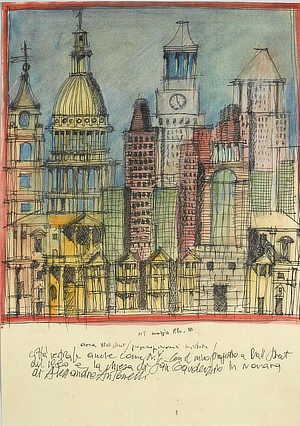
Aldo Rossi. Insulae, Berlin (Germany), Tchoban Foundation. Museum für Architekturzeichnung / Museum for Architectural Drawing, 4 february / 14 may 2023
The exhibition Aldo Rossi. Insulae at the Museum of Architectural Drawing, shown in collaboration with the Fondazione Aldo Rossi in Milan, presents over 110 graphic works and drawings by the renowned Italian architect Aldo Rossi (1931–1997), the majority of which are being shown publicly for the first time.
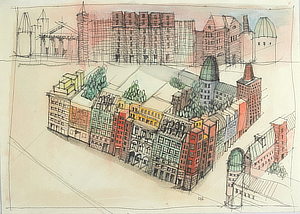 The title is taken from a series of Rossi's drawings shown in the exhibition from a Latin word insula referring to a separately standing house, a method of construction that Rossi often incorporated in his architecture. The exhibition consists of three parts: “Corpus Mediolanensis”, “Insula” and “Works for Berlin”. These three “insulae” seek to show Rossi’s unmistakable signature, including his sense of forms and geometry, his historical references, the influence of antiquity on his work and his frequent poetic references to both architecture and art. The title is taken from a series of Rossi's drawings shown in the exhibition from a Latin word insula referring to a separately standing house, a method of construction that Rossi often incorporated in his architecture. The exhibition consists of three parts: “Corpus Mediolanensis”, “Insula” and “Works for Berlin”. These three “insulae” seek to show Rossi’s unmistakable signature, including his sense of forms and geometry, his historical references, the influence of antiquity on his work and his frequent poetic references to both architecture and art.
An introduction to the architect's graphic work is provided by the exhibits in the “Corpus Mediolanensis”; consisting of coloured and re-drawn single-prints that Rossi made between 1986 and 1987. With other historical works, they present a survey of 30 years of his architecture and design, with references to more personal aspects of his poetics.
A special role in Rossi's oeuvre is played by “Insula”, a series of drawings inspired by models from antiquity and their reinterpretation by Baroque artists such as Giovanni Battista Piranesi and Claude Lorrain. In complete contrast to the zeitgeist of the 1970s, which animated architects and artists to create a better architecture or even a better society by breaking with the past, Rossi found his models in the buildings of earlier centuries. On this basis, he developed his own architectural language marked by the characteristic geometrical forms which have been found in architecture since ancient times, such as triangles and cylinders, and which Rossi re-interpreted in his work.
In addition to his native Italy, Berlin played an important part in his career: Rossi designed unique projects for the German capital. Some of these, like the Schützenstraße Quarter, were realised, while others, such as the project for the German Historical Museum, remained on paper. |
|
|
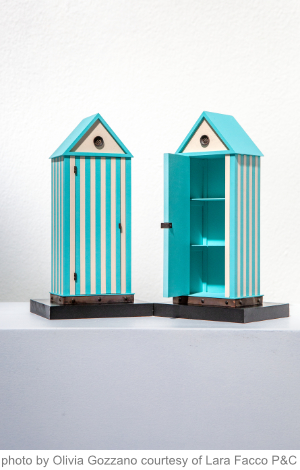
Aldo Rossi. Cabina dell’Elba, Milano [Milan] (Italy), Antonia Jannone Disegni di Architettura, 8 november / 29 december 2022
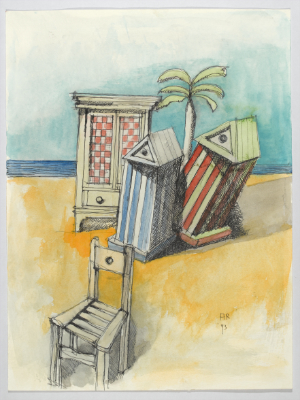 La galleria Antonia Jannone Disegni di Architettura presenta il progetto Aldo Rossi. Cabina dell’Elba interamente dedicato alla celebre cabina-armadio disegnata dall’architetto negli anni Settanta durante un soggiorno all’Isola d’Elba. La galleria Antonia Jannone Disegni di Architettura presenta il progetto Aldo Rossi. Cabina dell’Elba interamente dedicato alla celebre cabina-armadio disegnata dall’architetto negli anni Settanta durante un soggiorno all’Isola d’Elba.
Dopo il primo progetto per Molteni&C. in soli quattro esemplari e la presentazione al “Salone del Mobile” del 1980, nel 1982 Aldo Rossi inizia la produzione della seconda e definitiva versione della Cabina dell’Elba in collaborazione con l’atelier di produzione artigianale di Bruno Longoni.
«La cabina è una piccola cosa, è la riduzione della casa, è l'idea della casa», ha scritto l’architetto raccontando il suo interesse per il «carattere particolare e universale delle cabine poste sulle spiagge», motivo ricorrente in molti dei suoi progetti. La cabina, infatti, resta un modello esemplare del metodo progettuale di Rossi, della sua ricerca sulla scala e della sua volontà di trasferire motivi architettonici nello spazio domestico.
In occasione della mostra, a 40 anni dalla prima messa in produzione, la galleria ha realizzato, in collaborazione con gli Eredi Aldo Rossi e il supporto scientifico della Fondazione Aldo Rossi, un’edizione di nove miniature della Cabina dell’Elba partendo dal modello di studio realizzato da Bruno Longoni Atelier d’arredamento con Rossi nei primi anni ottanta. Oltre alle nove riproduzioni in legno dipinto con rifiniture di metallo - cm 22 x 8 x 5,5 - saranno esposte anche quattro prove d’artista e alcuni disegni originali dell’architetto.
«Le cabine erano un’architettura perfetta, ma anche si allineavano lungo la sabbia e strade bianche in mattine senza tempo e sempre eguali. Posso ammettere che esse rappresentano qui un aspetto particolare della forma e della felicità: la giovinezza. Ma questa questione non è essenziale anche se è legata agli amori delle stagioni marine». (Da Aldo Rossi, Autobiografia Scientifica, il Saggiatore, Milano 2009). |
|
|
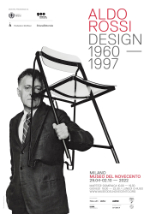 Aldo Rossi. Design 1960-1997, Milano (Italy), Museo del Novecento, 29 april / Aldo Rossi. Design 1960-1997, Milano (Italy), Museo del Novecento, 29 april / 2 october 6 november 2022
Il Museo del Novecento presenta Aldo Rossi. Design 1960-1997 a cura di Chiara Spangaro, in collaborazione con la Fondazione Aldo Rossi e Silvana Editoriale, dal 29 aprile al 2 ottobre. Con questa mostra il Museo del Novecento prosegue nel dialogo interdisciplinare tra le arti, caratteristico della contemporaneità, approfondendo la figura dell’architetto, designer, teorico e critico, tra i protagonisti della cultura visiva del XX secolo. Per la prima volta sono esposti, in un percorso spettacolare, oltre 350 tra arredi e oggetti d’uso, prototipi e modelli, dipinti, disegni e studi progettati e realizzati da Aldo Rossi dal 1960 al 1997, una testimonianza visiva della sua attività di designer, progettista e teorico dell’architettura.
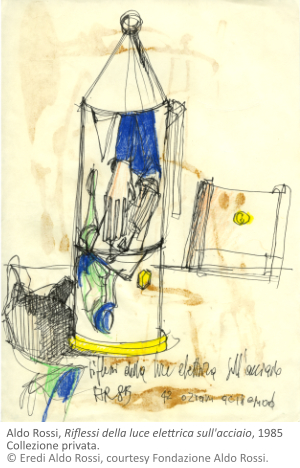 Rossi in tutta la sua produzione, fin dai primi mobili realizzati nel 1960 con l’architetto Leonardo Ferrari, riflette sul rapporto tra la scala architettonica e urbana e quella monumentale e oggettuale. Dal 1979 si apre al mondo della produzione industriale e di alto artigianato, realizzando arredi e prodotti d’uso prima con Alessi, poi con Artemide, DesignTex, Bruno Longoni Atelier d’arredamento, Molteni&C|UniFor, Richard-Ginori, Rosenthal, Up&Up (oggi UpGroup).
In quasi vent’anni di lavoro elabora più di 70 arredi e oggetti, molti dei quali ancora oggi in produzione, sperimentando forme e cromie nel campo dei metalli e del legno, del marmo e della pietra, della ceramica e della porcellana, dei tessuti artigianali e industriali e dei materiali plastici.
La mostra, il cui progetto di allestimento è firmato da Morris Adjmi - MA Architects, collaboratore e poi associato di Rossi a New York, racconta l’universo di Aldo Rossi in nove sale: ciascuna rappresenta un mondo nel quale emerge la relazione tra opere grafiche e prodotti artigianali e industriali, con riferimenti alle architetture e allo spazio privato di Rossi.
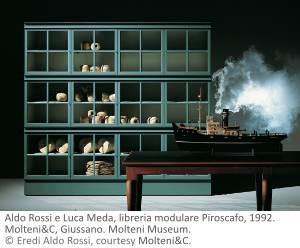 La prima sala ci introduce al rapporto tra immagine dipinta e realtà oggettuale, la seconda è dedicata a prototipi e varianti di un immaginario panorama domestico e porta alla ricostruzione di un ambiente poetico nella terza sala, dove opere quali la serie Parigi (UniFor, 1994) e il servizio Tea & Coffee Piazza (Alessi, 1983) sono il centro visivo e metafisico, corredato alle pareti dai disegni inediti degli interni della casa di Rossi in via Rugabella. La quarta sala presenta la varietà della produzione oggettuale, in rapporto con la forma del cubo che rievoca il Cimitero di San Cataldo a Modena e introduce le figure geometriche apollinee utilizzate dall’architetto sia nel design sia nell’architettura, tema della quinta sala: dai prototipi per Richard- Ginori e Rosenthal, alle piante architettoniche del Monumento ai Partigiani di Segrate e della scuola di Fagnano Olona, ai tappeti realizzati con ARP Studio in Sardegna (1986) o le tarsie lignee di Bruno Longoni Atelier d’arredamento (1997). Nella sesta sala sono allestiti sedie, poltrone, grandi mobili e le loro varianti per materiale e colore, dalla scrivania Papyro (Molteni&C, 1989) al tavolino Tabularium (Up&Up, 1985). La ricostruzione dell’interno domestico della sala sette riunisce mobili e oggetti di Rossi con altri da lui collezionati e presenti nelle sue case, tra i quali le caffettiere americane, una stampa di Giovanni Battista Piranesi, una credenza ottocentesca che è servita da ispirazione per il suo design, così da entrare idealmente nel suo spazio personale. Il rapporto con l’architettura, puntuale in tutta la mostra, è evidente nel nucleo dedicato agli arredi ideati da Rossi per alcuni suoi edifici presentato nell’ottava sala: la seduta per il Teatro Carlo Felice di Genova (Molteni&C|UniFor, 1990) o la sedia Museo costruita per il Bonnefanten Museum di Maastricht (UniFor, 1994). La presenza magica e misteriosa del Teatro del Mondo, che chiude la mostra, rievoca le costruzioni temporanee in legno – dal faro alla cabina, al teatro galleggiante e circolarmente riporta al nucleo di opere iniziali. La prima sala ci introduce al rapporto tra immagine dipinta e realtà oggettuale, la seconda è dedicata a prototipi e varianti di un immaginario panorama domestico e porta alla ricostruzione di un ambiente poetico nella terza sala, dove opere quali la serie Parigi (UniFor, 1994) e il servizio Tea & Coffee Piazza (Alessi, 1983) sono il centro visivo e metafisico, corredato alle pareti dai disegni inediti degli interni della casa di Rossi in via Rugabella. La quarta sala presenta la varietà della produzione oggettuale, in rapporto con la forma del cubo che rievoca il Cimitero di San Cataldo a Modena e introduce le figure geometriche apollinee utilizzate dall’architetto sia nel design sia nell’architettura, tema della quinta sala: dai prototipi per Richard- Ginori e Rosenthal, alle piante architettoniche del Monumento ai Partigiani di Segrate e della scuola di Fagnano Olona, ai tappeti realizzati con ARP Studio in Sardegna (1986) o le tarsie lignee di Bruno Longoni Atelier d’arredamento (1997). Nella sesta sala sono allestiti sedie, poltrone, grandi mobili e le loro varianti per materiale e colore, dalla scrivania Papyro (Molteni&C, 1989) al tavolino Tabularium (Up&Up, 1985). La ricostruzione dell’interno domestico della sala sette riunisce mobili e oggetti di Rossi con altri da lui collezionati e presenti nelle sue case, tra i quali le caffettiere americane, una stampa di Giovanni Battista Piranesi, una credenza ottocentesca che è servita da ispirazione per il suo design, così da entrare idealmente nel suo spazio personale. Il rapporto con l’architettura, puntuale in tutta la mostra, è evidente nel nucleo dedicato agli arredi ideati da Rossi per alcuni suoi edifici presentato nell’ottava sala: la seduta per il Teatro Carlo Felice di Genova (Molteni&C|UniFor, 1990) o la sedia Museo costruita per il Bonnefanten Museum di Maastricht (UniFor, 1994). La presenza magica e misteriosa del Teatro del Mondo, che chiude la mostra, rievoca le costruzioni temporanee in legno – dal faro alla cabina, al teatro galleggiante e circolarmente riporta al nucleo di opere iniziali.
Aldo Rossi. Design 1960-1997 conduce lo spettatore in un racconto inaspettato, immaginifico e spettacolare che si muove tra forma e uso, classicità, ironia e metafisica, nel quale la libreria ha la foggia di un Piroscafo (con Luca Meda per Molteni&C, 1991), La conica o La cupola sono ora macchine per il caffè (Alessi, 1984 e 1988) ora elementi allestitivi del Teatro Domestico (XVII Triennale di Milano, 1986), il Faro, già teatro a Toronto e museo nell’isola di Vassivière, è una teiera in vetro e ceramica per Rosenthal (1994) o il Monumento di Segrate si affaccia da una tarsia lignea per Bruno Longoni o da un tappeto tessuto in Sardegna. |
|
|
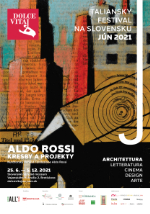 Aldo Rossi. Kresby a projekty, Bratislava (Slovakia), Sídelná budova SNM, 25 june / 5 december 2021 Aldo Rossi. Kresby a projekty, Bratislava (Slovakia), Sídelná budova SNM, 25 june / 5 december 2021 |
|
|
|
A desire of expressing the greatness of his gaze, the complexity of his thoughts and research and the variety of Rossi's work is w 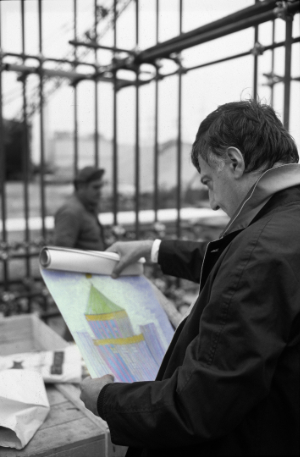 hat breathes life into an exhibition which is extremely rich in materials, with over 800 pieces including documents, correspondence, models, sketches, drawings and photographs coming mainly from the archives of Aldo Rossi preserved in the MAXXI Architettura Collection and by the Aldo Rossi Foundation, as well as important loans, courtesy of the IUAV of Venice - Archivio Progetti, the Deutsches Architektur museum in Frankfurt, and the Bonnefantenmuseum in Maastricht. 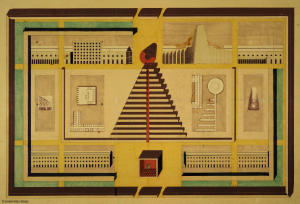 In addition to Rossi's own works, the exhibition boasts photographic images coming from the many important photographers who have measured themselves against his work and have thus enriched the meaning of each work of architecture with their own personal touch. In addition to the famous images by Luigi Ghirri, the exhibition also features those by other important photographers of the likes of Gabriele Basilico, Giovanni Chiaramonte, Ugo Mulas, Mario Carrieri, Stefano Topuntoli, Antonio Martinelli, Marco Introini. In addition to Rossi's own works, the exhibition boasts photographic images coming from the many important photographers who have measured themselves against his work and have thus enriched the meaning of each work of architecture with their own personal touch. In addition to the famous images by Luigi Ghirri, the exhibition also features those by other important photographers of the likes of Gabriele Basilico, Giovanni Chiaramonte, Ugo Mulas, Mario Carrieri, Stefano Topuntoli, Antonio Martinelli, Marco Introini.
The exhibition is divided into two large sections, one narrating his projects in Italy, the other those around the world and three additional thematic; the first revisits his years of training in Milan, the others are dedicated to two of the most iconic projects carried out by Rossi: the Modena cemetery and the The Theatre of the World in Venice.
The exhibition itinerary starts from the very first thematic area, in the middle of Gallery 2, which is dedicated to the early years of his professional training in a post-war Milan, which was still recovering from the bombings and was immortalised through the camera of Enrico Peressutti. There, in the newsroom of Casabella by Ernesto Nathan Rogers or at the Casa della Cultura directed by Rossana Rossanda, emerged both the ethical need of a young Aldo Rossi to contribute to an architectural culture able to face the challenges of rebuilding after the devastation, and the poetic language that will be his faithful companion throughout his life. In this section, the vast scale replica of the Duomo Cathedral in Milan that Rossi kept in his studio can also be found.
At the two opposite ends of the Gallery are the thematic areas on the Modena Cemetery and that on The Theatre of the World.
Rossi thought of the Modena cemetery, designed in 1971 with Gianni Braghieri and to this day still unfinished, as a city of the Dead, composed of straight arcaded paths featuring two archetypal architectural figures at both ends: a red cube and a cone. This city of the Dead, notwithstanding its being so essential and metaphysical, stands very powerful and evocative, just as in the famous photograph by Luigi Ghirri, where the red cube, a shrine of the Dead during war, emerges on a white blanket of snow and is exhibited here with other photos that Ghirri took at the cemetery for the Lotus International magazine, as well as Stefano Topuntoli's aerial footage, that documented the rapport with the territory. The video-gallery is located just behind this thematic area, broadcasting the movie Ornamento e delitto written by Rossi himself with Gianni Braghieri and Franco Raggi for the XV Milan Triennale as well as interviews, speeches at conferences and documentaries.
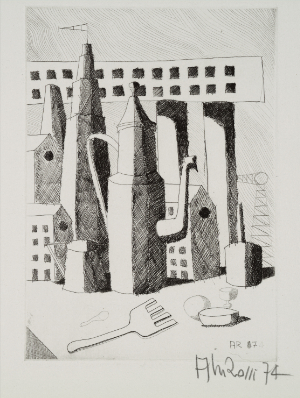 The Theatre of the World stands moored in one of the most visible places in the world. This as evocative, joyful and ephemeral theatre unlocked the doors to international fame for Rossi. Built for the first Architecture Biennale directed by Paolo Portoghesi in 1980, this small floating theatre was located in front of the Punta della Dogana. At the end of the Biennale, it sailed to Dubrovnik and, once back in Venice, it was dismantled. Its construction and incredible journeys are documented in the drawings and the scale model as well as by the photographs by Antonio Martinelli. The Theatre of the World stands moored in one of the most visible places in the world. This as evocative, joyful and ephemeral theatre unlocked the doors to international fame for Rossi. Built for the first Architecture Biennale directed by Paolo Portoghesi in 1980, this small floating theatre was located in front of the Punta della Dogana. At the end of the Biennale, it sailed to Dubrovnik and, once back in Venice, it was dismantled. Its construction and incredible journeys are documented in the drawings and the scale model as well as by the photographs by Antonio Martinelli.
Behind this thematic area, the Piroscafo bookcase, designed thirty years ago with Luca Meda (1991) and produced by Molteni&C, hosts the Quaderni Azzurri (blue notebooks), a sort of personal journal with thoughts, notes, memories and drawings that inspired the quotations of the whole itinerary of the exhibition.
Also the Parigi chairs (1989) produced by UniFor are on display in this area.
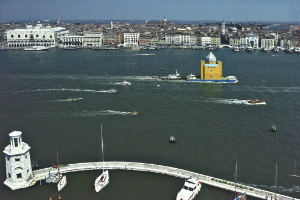 All along Gallery 2, in a busy and crowded central corridor that recalls a city’s urban fabric, 40 models are on display laying the basis of the two main sections of the exhibition. These are dedicated to the projects carried out in Italy and in the world, fragments of a poetic yet realistic tale of the cities, where the specific colours and features of the buildings breathe life even into faceless contexts. All along Gallery 2, in a busy and crowded central corridor that recalls a city’s urban fabric, 40 models are on display laying the basis of the two main sections of the exhibition. These are dedicated to the projects carried out in Italy and in the world, fragments of a poetic yet realistic tale of the cities, where the specific colours and features of the buildings breathe life even into faceless contexts.
These models interact with technical drawings, photographs, artistic drawings of different formats and made in ink, wax, pastel, watercolour, just like architectural compositions and fantasies, where real-life, out of scale objects are mixed up with architectural elements, creating fantastical urban scenarios. Drawings and photographs are arranged on the wall and on 40 tables created ad-hoc for the occasion by Molteni & C. In addition, several cases are lined up on the walls exploring more in depth different aspects of Rossi's work and thought, such as teaching at the IUAV, his relationship with the Venice Biennale and the Milan Triennale, as well as the one he had with the city of Berlin and with America, his discovery of Japan, his passion for the movies, his editorial activity, and his successful books such as The architecture of the city, translated all over the world, or the Scientific Autobiography, a sort of personal journal in which the creation of projects and the studying become one with his personal history.
In the section dedicated to his projects in Italy, stands a large 2x2m drawing of the famous the Analogous City, a remarkable reflection on an imaginary city, suspended between memory and desire, represented through the combination of urban features, historical pieces of architecture and projects all by Rossi himself. The Analogous City also features an experimental application developed by Dario Rodighiero, which allows the viewer to select any element of the painting and provides relevant information and references for further information.
Then come the projects for two of the most important Italian theatres, the Carlo Felice in Genoa and the Fenice in Venice, those for the Piazza di Fontivegge in Perugia as well as the “Gallaratese” in Milan, a long urban building which recalls the typical Lombard case a ballatoio, set within a larger housing development designed by his fraternal friend Carlo Aymonino, both intended as attempts to confer an urban dimension to the suburbs.
Among his projects abroad, which started with the large panel of the relief of the city of Zurich, which Rossi created during the years spent teaching at the ETH in this Swiss city, a significant one is the Bonnefantenmuseum in Maastricht, which is located on the edge of the Meuse river and is the most important museum built by Rossi.
The author of many museum projects and as many set-ups, he also designed the colourful complex of the Schützenstrasse in Berlin, a mischievous way of criticising the grey reconstruction of the German capital; the Disney Headquarters in Orlando, a colourful urban element in which the historical shape of Italian cities blend in with the verticality of their American counterparts. |
|
|
| Aldo Rossi, Santi Caleca. Monumental Memento, Milano (Italy), Antonia Jannone Disegni di Architettura, 7 december 2020 / 30 january 2021 |
|
|
| Aldo Rossi e la Ragione. Architetture 1967-1997, Padova (Italy), Palazzo della Ragione, 1 june / 29 september 2019 |
|
|
| Macchina Modenese, Modena (Italy), Laboratorio aperto all’ex Centrale Aem, 21 march / 19 april 2019 |
|
|
| Aldo Rossi e la cornice veneziana, Venezia, Università Iuav, Tolentini, Galleria del Rettorato, 24 october / 13 december 2017 |
|
|
| Aldo Rossi. Il Gran Teatro dell'Architettura, Milano, Galleria del Progetto, Scuola di Architettura Urbanistica Ingegneria delle Costruzioni, Politecnico di Milano, 19 october / 17 november 2017 |
|
|
| Aldo Rossi e Milano, Milano, Fondazione dell'Ordine degli Architetti, 4 april / 5 may 2017 |
|
|
| Aldo Rossi. Autobiografia poetica, Milano, Galleria Antonia Jannone, 12 november / 16 december 2014 |
|
|
| Aldo Rossi. Opere dal 1980 al 1996, Milano, Galleria Jannone, 20 settembre / 31 october 2012 |
|
|
| Aldo Rossi. Teatri, Venezia, Magazzino del Sale, 30 june / 25 november 2012 |
|
|
| L’architettura della città, Venezia, Spazio espositivo Gino Valle, Sede Cotonificio Università IUAV, 28 october / 8 november 2011 |
|
|
| Un Architetto_un’Azienda, Aldo Rossi_Molteni&C, Padova, Centro culturale San Gaetano, 5 / 11 october 2011 |
|
|
| Aldo Rossi. Opere dal 1970 al 1980, Milano, Galleria Jannone, 19 october/30 november 2010 |
|
|
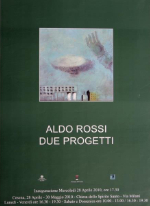 Aldo Rossi. Due progetti. Architettura 38, Cesena, Chiesa dello Spirito Santo, 28 april/30 may 2010 Aldo Rossi. Due progetti. Architettura 38, Cesena, Chiesa dello Spirito Santo, 28 april/30 may 2010 |
|
|
| Maurizio Scaparro (ed.), La Biennale di Venezia 1979-1980. Il Teatro del Mondo 'edificio singolare'. Omaggio ad Aldo Rossi, Venezia, Ca' Giustinian, 10 february/31 july 2010 |
|
|
| Aldo Rossi. Identità lombarda e vocazione internazionale, Milano, Spazio mostre del Politecnico di Milano, Campus Bovisa, 26 january/6 february 2009 |
|
|
| Disegni di Aldo Rossi, Milano, Galleria Giò Marconi, 16 april/17 may 2008 |
|
|
Per Aldo Rossi, dieci anni dopo. Disegni e modelli di opere e progetti dal 1964 al 1997 dell’archivio personale di Aldo Rossi dalle collezioni DARC – MAXXI con testimonianze degli amici, Roma, Accademia Nazionale di San Luca, 18 december 2007/25 january 2008
review: Antonio Labalestra, "Distruggere l'architettura. La lezione di Aldo Rossi, dieci anni dopo", L'industria delle costruzioni 402, luglio-agosto/july-august 2008 [Architettura degli ospedali], "Argomenti" pp. 106-108 |
|
|
Aldo Rossi. Inediti, Cesena, Chiesa dello Spirito Santo, 1 giugno/24 luglio 2005
review: Elisabetta Vasumi Roveri, "Aldo Rossi: inediti privati", Il giornale dell'architettura 30, giugno 2005, "Mostre" p. 27 |
|
|
| Disegni di Architettura, Torino, Galleria Albertina, 1986 |
|
 |
 |
 |
CREDITS |
 |
|
 |
|
 |
 |
 |
| |
 |
| Biographical notes edit by Lara Facco P&C |
|
 |
  |
 |
|
|